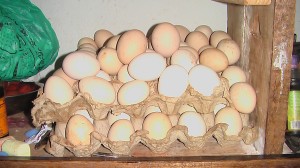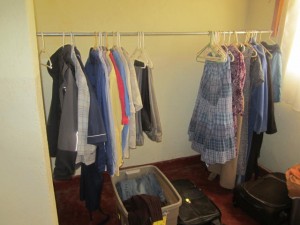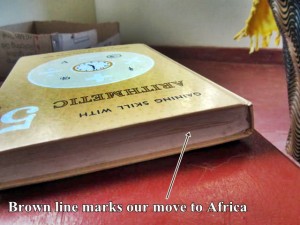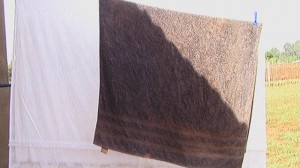Marc and I have noticed that here in Kenya, children are very often left to themselves. Usually, this is by necessity, because work for daily bread (whether working in the fields and at home, or wage-earning work, when it is available) is typically so demanding that parents aren’t left with much choice. In America, we took things for granted, like having a vehicle to hop into and a supermarket a short trip away. Here, you walk. Sometimes far. We always chuckle when we ask Jane how far away a particular destination is. She often shrugs and says, “Not far.” But it could be several kilometers–“not far,” indeed! We don’t leave our children home alone, but a single mother with few resources (or mom at home with Dad at work) sometimes has little choice.
When Marc went to Nairobi with our 10 year-old son a couple of weeks ago, he came back more than once to the house where he was staying to find the three children (ages 9 and under) home alone. He remarked that they were very well-behaved: no bickering, faithful behaviors (for the most part), and younger children who respected the authority of their older siblings in the parents’ stead.
We agreed, this would probably not be the case if we left all of our children home alone. My 10 year-old noted, “Well, they probably didn’t bicker because they had no toys to fight over.” Good point. As well, I don’t think our children have had enough opportunity to prove themselves responsible in taking care of their own needs for any extended period of time. They’ve only been apart from both of us a handful of times (usually when we go out to dinner to celebrate a birthday or anniversary), and the longest has been for the weekend, when they stayed with some friends of ours. Although we teach and train them in all things vital to home management, and they generally know our routines and expectations, they certainly derive a level of comfort in having an adult to fall back on. Unfortunately, I was sure that if left to their own devices, there are some things that they take for granted that would fall through the cracks.
So, with Marc and our oldest (a take-charge kinda kid) off to Nairobi for a few days, I decided to call a “Self-Sufficiency Day” for the rest of our crew, with the 10 year-old in charge. I thought it would be a good exercise for all of them. We went over the expectations, and I even wrote them on the chalkboard for reference. Things like:
- Do it God’s Way! Love and serve one another. Please God with your attitude and your behavior.
- Keep yourselves clean (hair, faces, feet, teeth) and LOOK AROUND to see what needs to be picked up around the house.
- Remember to change the baby’s diaper.
- Big kids, supervise little kids even if you are doing something else. Little kids, respect the authority of your older brothers and sisters.
And so on. They knew they would be responsible for their school work as well as home management, child care, and meal preparation. I would be closed in my bedroom and only available to receive meals or to feed the baby. (I also came out a couple of times to hook up the laptop and charge it on the inverter, but I told them to pretend I wasn’t there.)
My ten year-old spent part of the day before planning out AM and PM jobs for all the children, as well as meals. I have to admit, his choices were a little starchy (mandazi and tea for breakfast, beef broth with rice for lunch, and pasta for supper along with fried bananas and honey for dessert); however, I’m not sure how much better I would have done. The only fruit in the house was bananas and tomatoes. What can I say? We need to go to market! (That’s tomorrow…)
The morning went very well. My ten year-old kept everyone on-track and motivated in a very encouraging way. My oldest daughters teamed up to care for the littles and did a super job, even when multi-tasking to do their school work. My seven year-old did an admirable job with the laundry. (The only thing I had to return to the wash pile was a pair of jeans that needed a lot more elbow grease than she could muster. Ahhh, those boys of mine!)
The afternoon left something to be desired. The in-charge ten year-old got caught up in reading a new Thornton W. Burgess book that I had downloaded on the Kindle and before he knew it, it was 4:00 and everyone had far over-shot their afternoon “Free Time.” I actually had to prod them to move on with their afternoon responsibilities (including finishing their school work), which was a bit disappointing. I wondered what would have happened if I had not intervened? I guess I didn’t want to find out! However, after the reminder, things slipped back into gear. Jobs got done, supper got started, and school assignments got wrapped up.
I had given my 10 year-old a budget for the day of 200 shillings (roughly the equivalent of $2 and change, which buys quite a bit here). That would cover any supplies that we unexpectedly ran short of (such as laundry soap) or he could use it for some limited food items that could be purchased at the little shop/restaurant across the street (mostly staples like flour, oil, etc.). He considered buying the favorite “mandazi” from the restaurant at 50 shillings per bag of ten (and we’d need at least two bags); however, he did the math and realized that making them was much cheaper (and the recipe made a lot more–about 50!), so he was excited to make them himself. He ended up spending 18 shillings for 6 beef cubes, which he used to make broth for the lunch time rice, and he got a bag of sugar for 65 shillings to replenish our supply. Also, he ordered a litre of milk for 35 shillings to have tea for the next day. All in all, a total of 118 shillings spent for the day. Not bad. I had to chuckle, though, when I overheard him preparing breakfast in front of an audience of little people saying, “It’s almost ready! This is just taking a little longer than I thought!”
I sat down for supper with the crew and asked for their reactions. Over all, everyone was pleased with the day, though they admitted it was hard work. Since this was the kids’ first “solo” day, I had made some suggestions for AM and PM jobs, but I’m hoping that after some repeats of this type of training they will be on the lookout for what needs to be done and will need less direction. A good first stab at self-sufficiency. We’ll keep practicing. My 9 year-old daughter can’t wait for the day she’s “in charge.” She’s pretty sure she can handle it.
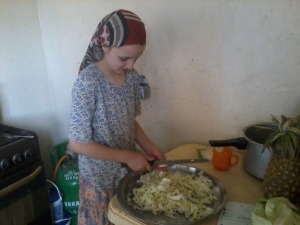 For a number of reasons, during this week I asked my oldest daughter, Rebekah (who will be 12 on Friday), if she wanted to take the week off of school and be my “Mother’s Helper.” On Monday she helped me move around the furniture in our sitting room/dining area. Yesterday, I asked Rebekah to do a short Circle Time with the Little ones, and she did such a good job that we talked about making it a more permanent daily arrangement. We have the rest of the week to see how she (and they) like it. Meanwhile, having a consistent second hand to assist with home management and homeschooling has been a real blessing to me…maybe that’s why I have finally found time to sit down and blog. 🙂
For a number of reasons, during this week I asked my oldest daughter, Rebekah (who will be 12 on Friday), if she wanted to take the week off of school and be my “Mother’s Helper.” On Monday she helped me move around the furniture in our sitting room/dining area. Yesterday, I asked Rebekah to do a short Circle Time with the Little ones, and she did such a good job that we talked about making it a more permanent daily arrangement. We have the rest of the week to see how she (and they) like it. Meanwhile, having a consistent second hand to assist with home management and homeschooling has been a real blessing to me…maybe that’s why I have finally found time to sit down and blog. 🙂
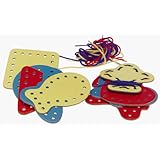 On occasion, I had also made my own sewing cards by cutting various shapes out of colored paper and laminating them, punching holes with a hole puncher, attaching yarn, and threading it on a plastic needle.
On occasion, I had also made my own sewing cards by cutting various shapes out of colored paper and laminating them, punching holes with a hole puncher, attaching yarn, and threading it on a plastic needle.
